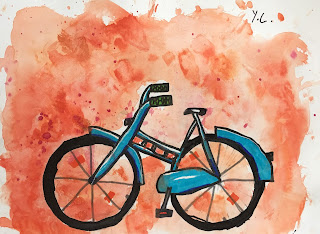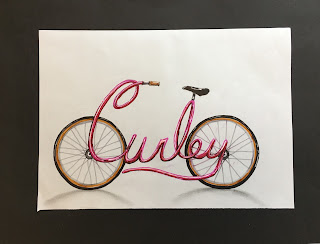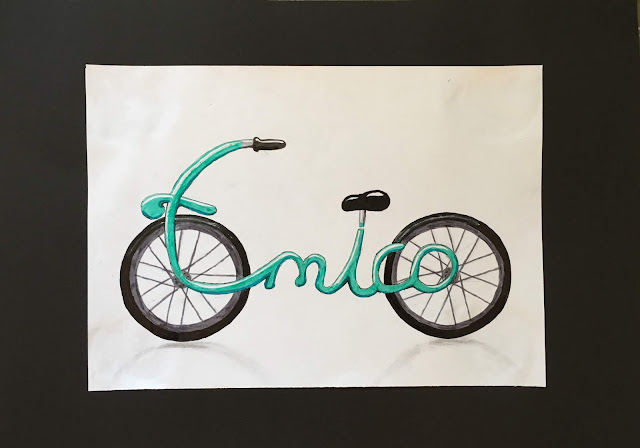 |
| 7-8 year olds |
To begin the new art semester for my little class (7-8 year olds) I wanted to do projects focusing on line and observational drawing, since these are fundamental to almost all the projects we'll be doing this year. And because we have a long summer break behind us, a line-focused project which exercises our fine motor skills and strengthens our observation skills, will get us back on the art track.
Bikes are challenging, fun to draw, and something all my students can relate to. They certainly tick off the element of line (curved, circular, straight, short, long, diagonal.... and the element of shape since we closed all our bike lines to create a bike frame (shapes) which we could then color. Other art thinking which cropped in to this project were symmetry, proportion, value (highlights and shadows created with marker), spacing, design and craftsmanship (overall neatness, closed line points, clean lines, careful coloring, etc).
 |
| Teacher Sample |
Bike Analysis
The objective was to draw a unique bike that appears 3-D. My students had visuals of bikes in many different styles at their table. We discussed what the frames looked like, where the wheels attach to the frame, where the seat and handlebars extend out from, where the pedal is attached, etc. Seeing many different bikes gave them ideas for their own bike.
Guided Drawing
We began with a guided drawing on the white board to get them going. First, we established where our wheels would go. They needed to have space at the bottom of the paper, and the same width of space on both the right and left sides of their paper. They used their fingers to measure this space. This helps them both center their bike for good visual composition, and will guarantee that they have enough space for their bike drawing to extend high above the wheels. Without this guide, most kids would probably plop their wheels down in the center of their paper, and they'd run out of space for their handlebars. No good.
We used empty masking tape rolls as wheel templates. Once we knew where our wheels would go. we traced in the inner circle for the wheel, and then around the outside for the bike tire, but you could also just free-hand the bike tire if you want it thicker than the template allows. Then we traced our second wheel. You could also use a ruler and draw a light line at the bottom of the paper where the wheels will go, to ensure that both wheels are solidly placed on the same hormonal line. But eye-balling this worked too.
Then we drew step-by-step: the chain cover starting in the center of the back wheel; mud guards on both wheels; the front frame (which is slightly slanted), the crossbar connecting the chain cover to the from handle bar; the two-pronged frame section that the seat sits on (we noted that the front frame where the handlebars is and the central frame where the seat is slant slightly to the same degree, so they are parallel.... a math concept that was beyond this age group, but they got the visual understanding that the bars slant the same way); the pedal; grips, etc. Students were shown options for details and looked at their bike visuals for ideas like lights, cross bar designs, bells, etc. We kept the spokes easy, by just doing the simple 'pizza slice' lines.
Corrections
We analyzed our bikes and made corrections where things did not line up, or where proportions were off. Some students extended their handle bars, enlarged their seat, or drew their grips larger. Recognizing what doesn't look 'right' and correcting it, is what makes us better artists, so this step is an important exercise.
Outlining
Once we had all our lines in place where we wanted them, we traced them with a black permanent marker and erased our pencil lines. We used a gray marker to trace the wheel spokes to create some softness, and so as not to overdo the black lines.
Coloring
I knew we'd be adding watercolor splashed backgrounds to our bikes, so we used waterproof Sharpie markers to color our bike, to prevent the ink from bleeding later. Students where to choose one color for their bike, and it's lighter value, so for a blue bike, students chose a middle blue and a lighter blue. We established our light source, and then colored the whole bike frame in our middle color, leaving out a strip of white where our highlight is. The only way to create white space with marker is to NOT COLOR THAT SPACE. Some kids found it easier to 'draw' in the white space (for example, a long oval shape along the top of their cross-bar), and then color around it. With our darker color, we added our shadows, which would be anywhere that is under, behind, beneath, overlapped by something etc. The kids got this concept easily. Bike tires were colored in with a thick permanent black marker. Seats and handle bars were also colored with attention to highlights and shadows. Now our bikes look 3-D!
Paint Splatter
We used a wet-on-wet watercolor technique to create the background and chose the complementary color to our bike. We wet our paper all around our bike with a medium brush, and then loaded up the brush up with lots of water and our color and simply dabbed it all around our paper. We then chose a second color NEXT TO our first color on the color wheel (analogous) and repeated. Students were encouraged not to scrub or 'paint' with their brush, but instead, dab and stipple the color onto their paper and let it do it's wet-on-wet magic. This creates more texture. Students were also encouraged to leave a 'frame' of unpainted space along the edges of their paper and not go all the way to the edge.
Voila! Adorable, proportional, detailed, 3-D bikes. My students loved this project.
























